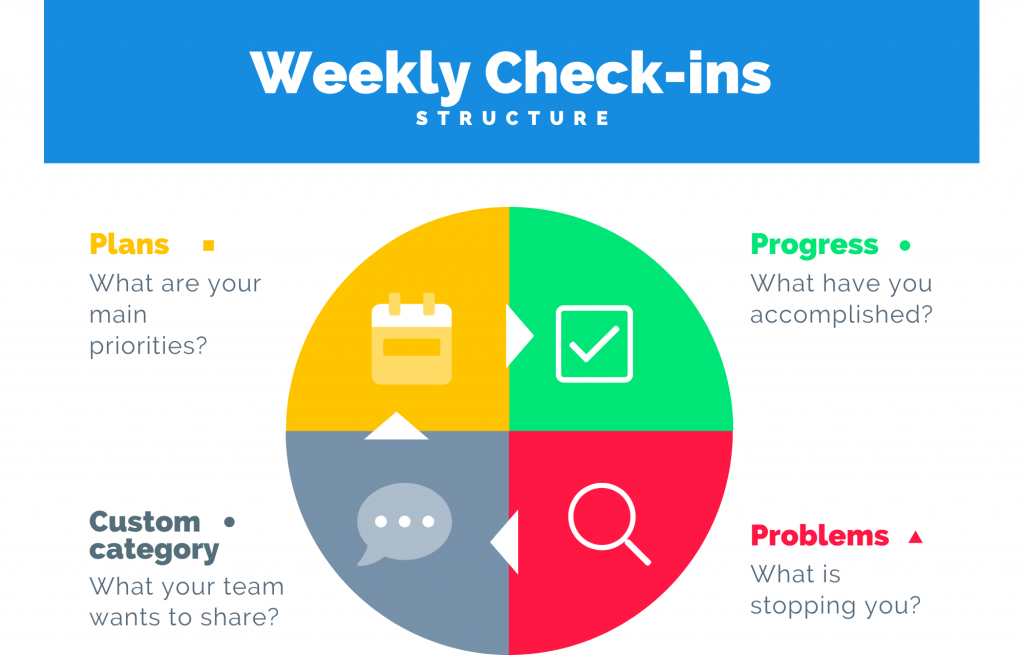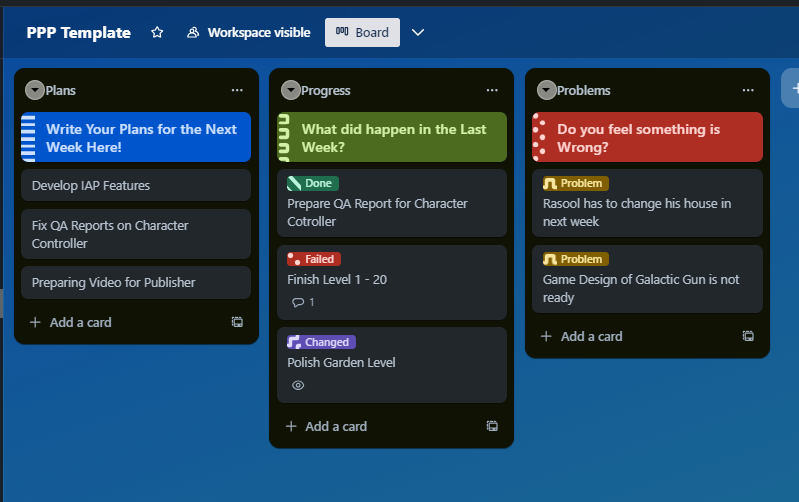Article by Mohammad Reza Arashiyan
The structure of our squads in Unbound Game Studio gives us the power to grant complete autonomy to each squad and Product Owner responsible for a project. However, an important point we have learned over the years is that Autonomy differs from Lack of Coordination. In our structure, Product Owners can independently configure and select the type of project execution, squad member structure, communication style, and session types, which we refer to as autonomy. However, to maintain coordination and team flow, support and services provided by other team sections (such as HR Coordinators, who play a more prominent role when squads go under crunch) are essential. Product Owners are obliged to determine their progress over the past week and set their goals for the upcoming week in a weekly session to ensure coordination and flow.
These weekly sessions are crucial for Communication and Project Monitoring, and choosing a suitable system for these sessions that conveys project details effectively has been a significant challenge from the founding of Unbound Game Studio until today. This is where PPP sessions have been able to create the best coordination among our internal structures.
What does the structure of PPP mean?
The name PPP sessions is derived from the combination of the first letters of the words Plans, Progress, and Problems. These titles precisely represent the topics discussed in each session. Indeed, you have to complete these 3 steps before each Meeting, and present them in the session.

What are PPP sessions suitable for?
The PPP session system is designed with the goal of connecting different sections of a team that have separate responsibilities but undeniable impacts on each other’s performance. Sections with separate roles but undeniable effects on each other’s performance.
For example, imagine you want to cut off a section’s connection with other sections with a knife in a way that the section can still meet its needs within the internal loop and survive. For instance, Project A and Project B team members are entirely independent, each working on their respective projects. If you intend to dissolve or stop Project A at some point, it will adversely affect Project B members, even though both Projects A and B are under a game single studio. The scope you have reached is a detachable part of the team that the PPP structure will function effectively on.
These sessions are also suitable when you want to delegate an activity in your layer to an individual while simultaneously monitoring its progress. In this case, you only need a broad overview of the activities and challenges of the individuals performing them for effective monitoring, without the need to communicate with each individual subordinate.
For example, in Unbound Game Studio, in the Weekly Product Owner sessions, we adhere to the rules and PPP system. Each Product Owner is responsible for a project and a squad. Next, I will provide an example of Unbound Game Studio’s Product Owner sessions to further discuss the PPP system.
How are PPP sessions conducted?
These sessions are based on three elements: 1)Board, 2)Presentations, 3)Members. Before starting each session, you have to complete your board, invite any guest (if you need to), and then start your presentation at the meeting.
1)The Board: Each project has its dedicated board and a person responsible for updating it. The board’s space should be in a place where all members can easily access it and understand what is expected to happen in the current week. (For example, a space similar to Trello.) Managers can easily understand the latest status of project progress by visiting these boards.
For example, in Unbound Game Studio’s Product Owner sessions, each project has a separate board, and a Product Owner is responsible for updating the board related to that project.

Each board consists of three columns:
- Plans column: In this column, tasks that the Product Owner intends to accomplish in the coming week are placed. Each card corresponds to a specific task. Note that these tasks should be scoped to be achievable by the entire team in a week, neither more nor less.
- Progress column: Before the session begins, all tasks that were in the Plans column last week must be moved to the Progress column this week. If these tasks have been successfully completed, they are labeled as “Done.” If they are incomplete or not yet started, they are labeled as “Failed.” If tasks have completely changed according to the team’s plan or the task’s base has changed, they are labeled as “Changed.” Note that all tasks present in the Plans column of the previous week (even if not started) must be moved to the Progress column. Additionally, in the comments section of Failed and Changed tasks, the progress status of the task or the reason for failure should be mentioned. After the PPP session is complete, uncompleted tasks will be moved back to the Plans column for the next week.
Note 1: In my opinion, a good Product Owner is someone who can make the most accurate predictions about the upcoming week. Because tasks are determined by these individuals themselves and no part of the task-taking process is imposed, it is expected that all tasks in the Plans column will be moved to the Progress column as Done. However, if this does not happen and simultaneously no external factor has affected the tasks in the Failed or Not Started columns, it means that the Product Owner did not have an accurate prediction of the volume of tasks they can accomplish. This issue is corrected and improved with practice over time.
Note 2: Exactly for the reasons mentioned above, tasks that have not yet started or have been incompletely done are both classified in the Failed category; because the failure to complete these tasks indicates an error in one of the functional aspects, such as planning.

Note 3: Maintaining the archive of comments for each task plays a crucial role in identifying team problems. If a task fails for consecutive weeks, as a manager, you can review its comments to understand the reasons for the delay or problems existing in that squad or in the team structure. Therefore, make sure to provide insightful comments for tasks.
- Problems Column: One of the most important sections of PPP is this column. The goal of having this column is to understand the problems within the squad, elements that bring external pressure to the squad, or solve dependencies that the squad has with external parts and couldn’t resolve independently. These problems generally lead to the failure of tasks. Therefore, Product Owners are always asked to mention any problems they feel currently, in the past week, or even in the future of the project as a separate card in the Problems column and refer to them during the presentation of the past week.
2) Presentations: These sessions can be conducted either in person or entirely online. After the start of the session, each Product Owner has 5 minutes to share his board and start presenting: a) the performance of the past week based on the Progress column, and b) the plan for the upcoming week based on the Plans column.
The presenter also provides knowledge sharing during their presentation. For example, if they have achieved a specific milestone in the tasks of the past week or tried a new solution, they can share their experience with the other teams during the session. After the presentation, if anyone in the audience has comments or something to add to the presenter’s remarks, they declare their opinion. For example, if the production section manager needs to review a new deadline for one of the projects, they can re-examine it in this section.
3) Members: In addition to presenters, other individuals can also participate in these sessions. For example, in Unbound Game Studio’s Product Owner sessions, the CTO also participates in understanding the technical needs and problems in production and provides suitable tools to solve the squads’ problems. In some sessions, Product Owners have specific dependencies outside their squads to complete their tasks. In this case, with the coordination of the session manager, the person they are dependent on is invited to participate in the session.
Is PPP planning suitable for your structure?
This entirely depends on your pipeline structure. My suggestion is to ask yourself the following questions:
As the first question: What resolution should I have in the flow of tasks and processes? Because the PPP structure is made for Monitoring a General View of the project. For high-resolution task management (or in fact, for Tracking each task) there are better structures (such as Scrum).
Secondly, you need to determine who should be present in your sessions. Based on personal experience, I believe that the level of participants and contributors should be higher than simple executive members. This means that attendees and participants should be responsible and accountable for managing their projects.
And thirdly, you need to determine how much freedom your teams have. The PPP system is generally suitable for projects with flexible deadlines and spaces where individuals have the freedom to make decisions and take on tasks. Otherwise, you should look for a system that performs task tracking or monitoring operations for you, rather than monitoring.
Conclusion:
As the ancients said, “Every saying has its time, and every project management system has its place!”
My belief is that you cannot repeat a fixed and static system in all parts of your team. I have seen this mistake among many of my friends who use systems like Scrum by applying them to all executive sections. This is the case where each technique has its own advantages and disadvantages, and the good performance of a technique in one section cannot be generalized to all other parts of the system. Therefore, as a manager, make sure you are proficient in various project management techniques so that you can use the appropriate technique for your needs in different sections.
